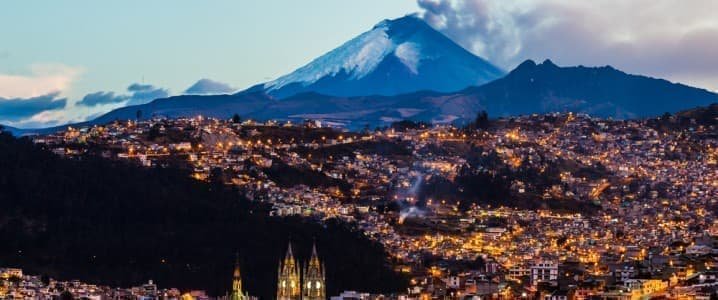By Felicity Bradstock – Nov 17, 2024, 10:00 AM CST
- Ecuador is facing a severe energy crisis due to a combination of drought, overreliance on hydropower, and poor policy decisions.
- Rolling blackouts have crippled the economy, causing job losses and business closures.
- The crisis highlights the urgent need for Ecuador to diversify its energy mix and invest in alternative renewable energy sources.

The government of Ecuador has mandated regular power cuts to help deal with the country’s energy crisis. The blackouts in November have been lasting from 4 am to 11 am and again from 3 pm to 10 pm, reducing access to power to just a few hours a day. While Ecuador’s reliance on fossil fuels is minimal compared to many other countries, the severe drought over the last year has hit the country’s hydropower sector hard. Hydropower has contributed around 70 percent of Ecuador’s electricity since 2017, but production has been far lower than normal this year. There have been rolling blackouts since 23rd September, which have grown worse in November, particularly during peak demand hours.
The blackouts have hit the economy hard. The Labour Ministry reports that over 3,500 jobs have been lost due to the power cuts, with small and medium businesses suffering the worst. Meanwhile, industry bodies suggest the energy crisis could have cost Ecuador’s economy at least $2 billion to date. Many businesses have had to rely on diesel generators to power operations in recent months, which compromises Ecuador’s reputation as a low-carbon energy country.
In 2016, then-president Rafael Correa inaugurated the Chinese-built $2.2 billion Coca Codo Sinclair hydroelectric dam. It was one of eight dams planned by the Correa government, in line with plans to nationalise energy. Coca Codo alone provides around 30 percent of Ecuador’s electricity needs when fully operational. However, due to construction faults, the facility is under threat of river erosion and a build-up of sediment. In addition, due to a year of severe drought, Coca Codo is running at just 30 percent capacity.
The government was warned by meteorologists that the El Niño weather pattern this year would likely result in reduced rainfall in the Amazon rainforest, which is where most of Ecuador’s hydroelectric dams are located. However, the longer-term threat of climate change could mean that Ecuador’s hydropower facilities are hit hard by drought for years to come, demonstrating the need for greater diversification in the country’s energy mix.
While the shortage of hydropower-generated electricity has exacerbated the country’s energy scarcity, several other factors have contributed to the crisis. Structural problems, including inadequate investment, poor policy decisions, slow reactions to repeated warnings, and a lack of preparation for severe weather events have resulted in a breakdown of Ecuador’s energy system.
Fernando Salinas, the president of the Ecuador Energy Forum, stated, “The politicians were resting on their laurels, thinking Ecuador’s power capacity was enough to meet the energy needs.” Salinas added, “There was planning, but it was not put into action.” Since Coca Codo, no new major new energy projects have been developed. Meanwhile, the Latin American country has seen around a 24 percent rise in demand for energy since 2016.
Correa’s government aimed to expand Ecuador’s energy industry through the creation of the electricity master plan, a strategic framework for sectoral development. The strategy outlined plans to develop more hydropower facilities across the country, diversify the energy sector to include more solar and wind projects, and maintain thermal plants to boost backup capacity in case of droughts. However, successive governments have failed to implement the strategy. The country’s thermoelectric plants have been long neglected, with only 879MW out of a 2,020MW capacity operational in October.
In April, when water levels were already extremely low, Ecuador’s President Daniel Noboa declared a state of emergency for the country’s energy sector and began to implement power cuts. Noboa has since fired three energy ministers. The president has sought to tackle the crisis by using floating thermoelectric power plants, but this has only marginally boosted Ecuador’s energy production. Other moves by Noboa include the reduction of taxes on imports of diesel-powered generators and batteries, as well as the creation of new incentives for private sector investment in energy projects.
While greater investment in the country’s energy sector could have helped prevent the crisis, Ecuador has suffered a larger economic crisis that has made financing a diversified energy mix almost impossible. Noboa inherited a deficit of $4 billion in the budget for 2024. However, investing in thermal plants could alleviate the effects of drought in the coming years and boost Ecuador’s energy security, providing the government with more time to develop other renewable energy sources.
Poor policy decisions, an overreliance on hydropower and a lack of investment in the maintenance of the country’s energy infrastructure have left Ecuador’s electricity sector in a state of emergency. People across the country are experiencing several hours of organised daily power cuts, which is hitting the already volatile economy even harder. Greater investment in thermal plants and the diversification of Ecuador’s renewable energy mix could help ensure the country’s energy security in the coming years, but this will require high levels of private investment in the energy sector.
By Felicity Bradstock for Oilprice.com
More Top Reads From Oilprice.com
- Space Junk: The Unseen Crisis Threatening Earth’s Ecosystems
- Saudi Arabia Seeks to Balance Relations with Iran and Israel
- Trump’s Energy Sanctions Are a Double-Edged Sword for Global Economy
![]()
Felicity Bradstock
Felicity Bradstock is a freelance writer specialising in Energy and Finance. She has a Master’s in International Development from the University of Birmingham, UK.


